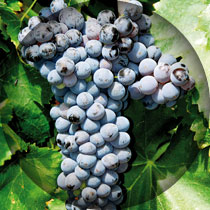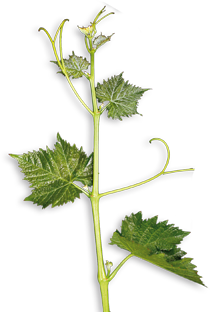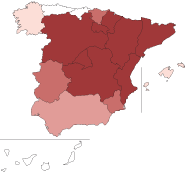Garnacha Tinta (ES)
Variety: red | Category I | Spain


General Information
Garnacha Tinta


Origin: Aragon is the assumed origin of this variety, already known at the time of the Islamic occupation. Today it is found all over the world in the warmer viticultural regions. According to La Finca El Encín, the Spanish national grapevine repository, the variety appeared in the 14th century as a Greek wine, and was blended under the name Varnacie. According to Valier (1882) the variety was planted in Aragon, and even before the Phylloxera epidemic, it appeared in France as Grenache. Abela (1885) knew the variety by the name Alicantina. Zuñiaga (1905) refers to the fact that the variety had also been introduced in Rioja before the vineyards of Aragon were destroyed in 1854 by Oidium, and at the time, it was known in the Madrid region as Tinto Aragonés or Aragonés (homonymous with the identical name given at the time to the Tempranillo in Castile and Leon). Marcilla (1942) describes it as the red grapevine variety most widely distributed in Iberia.
Chief areas of distribution: Aragon, Castilla la Mancha, Navarre.
Official synonym(s) (national and OIV): Gironet, Lladoner, Grenache (France).
Historic and regional synonyms: Garnacha, Tinto Aragonés, Roussillon, Grenache (France), Cannonau (Cerdeña), Alicante (Italy), Guarnaccia (Ischia, IT).
Homonym(s): Garnacha (blanca, gris, roja, peluda, tintorera).
Area under cultivation: 75,000 ha (Ministry of Agriculture, 2007).
Trend: Slight downward trend, but stabilising.
Varietal variability: Medium to high.
Availability of propagating material: There are several certified clones from various regions, e.g. CL-53, CL-55, CL-288, CL-294.
Molecular Profile (OIV)
Regional Classification
Morphology
Phenology
Vegetative Potential
Viticultural Parameters
Oenology
Variety Characteristics
| VVMD5 | VVMD7 | VVMD27 | VVS2 | ZAG62 | ZAG79 | ||||||
| Allele1 | Allele2 | Allele1 | Allele2 | Allele1 | Allele2 | Allele1 | Allele2 | Allele1 | Allele2 | Allele1 | Allele2 |
| 222 | 236 | 237 | 241 | 191 | 191 | 134 | 142 | 187 | 187 | 255 | 255 |
Young shoot (form of tip): Sparse hairs on shoot tip, with medium colouration. Young shoot bright green on dorsal and ventral surfaces at nodes and internodes, with dense or no hairs.
Young leaf: Very weak anthocyanin colouration of first six leaves, sparse hairs.
Young shoot: Green, with no, or sparse prostrate hairs.
Inflorescence (sex of flower): Hermaphrodite.
Mature leaf: Medium size, pentagonal. Open wedge-shaped petiolar sinus. Weak expression of main veins. Profile of blade in cross section revolute, shallow upper lateral sinuses, no hairs on veins, blade, or peduncle. Rectilinear teeth. Petiole shorter than main vein.
Bunch: Medium to large, very dense, short peduncle.
Berry: Medium size, round, uniform, dark red to violet colouration, difficult to detach, skin thin, flesh colourless, soft and very juicy.
Woody shoot: Brown, with stripes.
Time of bud burst: Normal, shortly after the Tempranillo.
Flowering: At the same time as the Tempranillo.
Berry (colour change): Normal to late.
Berry (harvest ripe): Medium, 5 days after the Tempranillo.
Vigour of shoot growth: Very high.
Pruning weight:: High.
Shoot attitude (habit): Heliotropic.
Length of internodes: Long.
Shoot length: Short.
Rate of multiple bud bursts: Low.
Bud fertility index: High (19% greater than the Tempranillo).
Yield: Medium to high (7% higher than the Tempranillo).
Sensitivity to abiotic factors: Very drought resistant Sensitive to Botrytis and Peronospora, susceptible to Bunch Rot.
Susceptibility to Pests: European Grapevine Moth (Lobesia botrana).
Bunch size: Medium to large.
Berry size: Medium.
Seeds per berry: 3-4.
Vineyard conduction system: Traditionally, the goblet training system, but nowadays, the cordon training system.
Pruning: Can be short pruned, but does equally well with long, or mixed pruning.
Green pruning: Strongly recommended at flowering in order to prevent yield problems.
Soil requirement: Suited to all soil types.
Climatic requirements: Moderately warm and dry in summer.
Rootstock: Poor compatibility with SO4. Risk of coulure with P1103.
Incidence of coulure/millerandage: High.
Spoilage of mature berries: Minimal.
Risk of bird damage: No special risk.
Machine harvest suitability: Well suited.
Hand harvest suitability: Suitable.
Wine type: Noble young rosé wine. Because of the noble grape's low acidity, it makes a good red wine blend.
Potential alcohol content: The sugar content is below the average of comparable varieties, but can reach high levels in warmer regions.
Natural acidity of must: At 6.3 g/l, the total acid content is not particularly high, but it is 1 g/l above that of the Tempranillo.
Total anthocyanins: Medium.
Risk of oxidation of must: High.
Tendency towards acidity loss in fermentation: Medium.
Colour intensity of wine: Comparable with the Tempranillo.
Wine colour tonality: High, with a tendency towards yellow tones.
Tannins: Medium to high.
Total polyphenol index (at 280 nm): 35 – 45. Maturity of the harvest and the maceration technique are important factors in determining phenolic composition.
Risk of oxidation of wine: The young wine, suitable as a varietal, tends towards oxidation.
Aromatic profile: Terpenoid aromas evoke fresh fruit.
Ageing Potential: Very good in cooler regions, although problematic in hot climates.
Blending recommendation: Tempranillo, Cabernet Sauvignon, Syrah and Graciano.
Suitable as a varietal: Very suitable as a young wine.
Wine Descriptors: A wine high in alcohol, garnet red colouration, with a range from light aromatic notes to those of ripe red fruits, of medium acidity, with a simple structure, or one of medium complexity.
Wine quality: Spanish premium grapevine variety, which produces a good yield of good quality.
Variety Characteristics: Fresh, fruity young wine with high yield potential.

